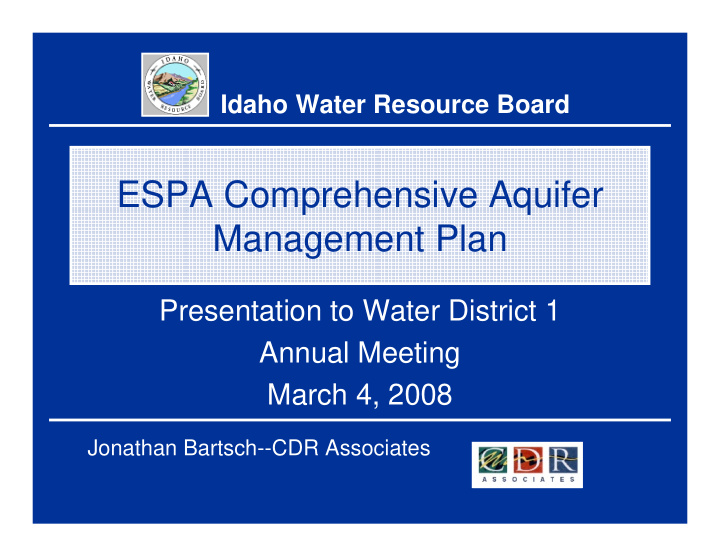



Idaho Water Resource Board ESPA Comprehensive Aquifer Management Plan Presentation to Water District 1 Annual Meeting March 4, 2008 Jonathan Bartsch--CDR Associates
Outline • Background and Framework Development process • Formation and Operation of Advisory Committee • Key Topics and Issues Addressed by Committee • Initial Board and Committee Recommendations – Study of Minidoka Dam Enlargement – Voluntary Demand Reductions in the ESPA – ESPA Recharge
Idaho Water Resource Board Comprehensive Aquifer Management Plan Background • Framework Plan funded by 2006 Legislature, SCR 136 • Board conducted extensive stakeholder outreach to develop an ESPA CAMP Framework (2007) • 2007 Legislative funding and authorization included technical studies and a facilitated planning effort, HCR 28 and HB 320. • Framework identified a goal and objectives for aquifer management • Currently finishing year two of a three year effort with the objective presenting a completed plan to the 2009 Legislature.
Framework Goal for Aquifer Management Sustain the economic viability and social and environmental health of the Eastern Snake Plain by adaptively managing a balance between water use and supplies.
Framework Objectives for Aquifer Management • Increase predictability for water users by managing for reliable supply • Create alternatives to administrative curtailment • Manage overall demand for water within the Eastern Snake Plain • Increase recharge to the aquifer • Reduce withdrawals from the aquifer
Background and Framework Development Process • Framework identified interim measures – Recharge – Conservation Reserve Enhancement Program (CREP) – Targeted Demand Reduction – Groundwater Model • Framework recommended creation of an Advisory Committee to develop the CAMP
Background and Framework Development Process • Pursuant to House Bill 320 the Board created and convened the ESPA CAMP Advisory Committee – Broadly based representatives across ESPA charged with developing consensus-based recommendations to Board (18-month process) – Focus on long-term aquifer management plan – Guided by the Framework Goal and Objectives
Formation and Operation of the Advisory Committee • Committee composition established through a stakeholder nomination and Board selection process • 16-member Committee met for first time in May 2007 • 10 Committee meetings and numerous sub- committee meetings held • Meetings convened across the ESPA • Operating Protocols established – Consensus-based decision making process
Formation and Operation of the Advisory Committee • Committee Work Plan Developed – Targets –establish quantitative 5 and 10, 20 and 30 year targets – Management Actions – identify tools to achieve targets – Funding Mechanisms – develop funding strategies to implement actions – Adaptive Management Plan – develop plan to assess progress toward qualitative and quantitative goal and objectives
Key Topics and Issues Addressed by Advisory Committee • The Model – The Eastern Snake Aquifer Hydrologic Model was discussed as a planning tool and aid to CAMP development • Settlement Efforts – Reviewed and discussed previous efforts to address ESPA issues • Funding – Initial funding strategy principles reviewed
Key Topics and Issues Addressed by Advisory Committee • Management Alternative Matrix – Managed and incidental recharge – Conservation Reserve Enhancement Program – Additional surface water storage – Groundwater to surface water conversions – Buy-outs and subordination agreements – Below Milner dam salmon flow augmentation exchanges – Dry-year leasing – Crop mix (incentives to plant low-water use crops) – Weather modification – Water conservation measures
Key Topics and Issues Addressed by Advisory Committee • Quantitative Goal Analysis – Evaluation of reach gain and water level changes from a 900kaf change in water budget – Review of management action assumptions to accomplish change – Deliberation regarding quantitative goal targets, implementation and benefit timeframe, impacts and magnitude of costs – Evaluation against goal and objectives
Initial Board and Committee Recommendations • Study of Minidoka Dam Enlargement – Scheduled for reconstruction in 2011 – Dam raise could increase available supply between 40kaf and 50kaf annually in ESPA – Management actions such as ground water to surface water conversions and others require increased surface water storage – Immediate allocation required to complete necessary studies or State will lose opportunity Estimated Cost: $1.4 million to support DT3 feasibility analysis.
Slide 13 DT3 I added some text, because I think it is important to spell out exactly what the money will be used for. They'll ask! Diane Tate, 2/18/2008
Initial Board and Committee Recommendations • Voluntary Demand Reductions (to reduce demand component of ESPA water budget) – Buy down select water rights – Pursue subordination agreements – Execute short or long term dry-year lease agreements (including CREP augmentation in targeted areas) Estimated Cost: $5 million to pursue demand reductions in 2008.
Initial Board and Committee Recommendations • ESPA Recharge – Framework objectives include increasing recharge to aquifer. – Additional funds necessary to support activities within existing facilities (canals) • Measurement of recharge water • Construction of appropriate facilities • Water wheeling • Renting storage water Estimated Cost: $ 1 million to conduct recharge activities in 2008.
Questions?
Recommend
More recommend